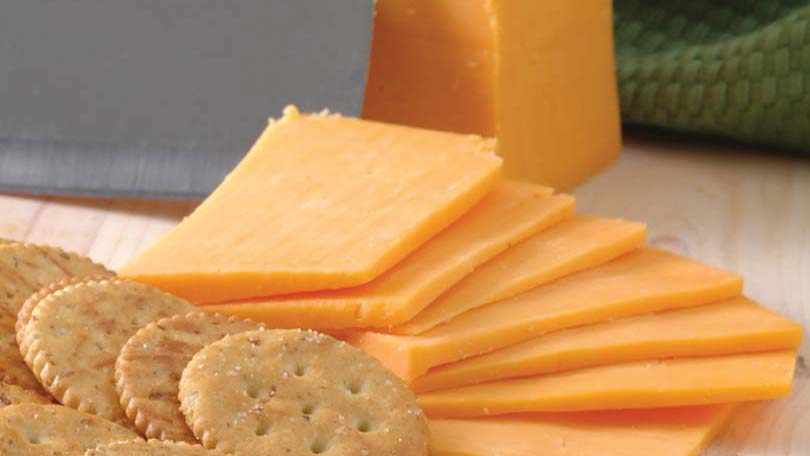
It is hard to conjure a mental picture of cheese without including the familiar orange of cheddar. This kitchen staple holds value as a tasty snack food as well as a versatile ingredient in recipes from all over the world.
Cheddar’s history is almost as rich as its distinctive flavor. In 1724, famous author Daniel Defoe dedicated an entire section of his ‘A Tour of the Islands of Great Britain’ to the Somerset village of Cheddar and its cheese. But the cheese had already gained fame on its own merit.
Records indicate that King Henry II (who declared cheddar cheese to be Britain’s best) purchased 10,240 pounds of the stuff in 1170. His son, Prince John, purchased nearly the same amount fourteen years later.
Cheddar cheese continued to be a royal favorite, and by the reign of Charles I, it had become so highly regarded that it was commissioned and purchased before it was even made and it was only available in the king’s court.
The scope of the cheese’s preferred status broadened over the years. In fact, more than 3,500 pounds of cheddar accompanied Captain Robert Scott aboard the Discovery during his 1901 expedition to Antarctica.
Cheddar’s specific origins are not exactly known. One legend is that a milkmaid, fearing for her safety, hastily abandoned her pail of milk in the Cheddar Caves. When she returned, the milk had produced what we now call cheddar cheese.’
We do know that the cheese was indeed born in Cheddar, where much of the cheese’s traditional flavor has been attributed to the county’s grazing pastures. Additionally, the Cheddar Caves had provided an ideal 7-degrees storage environment; those days are gone, however, as the cozy caves with their delicious contents ended up attracting rodent visitors.
Cheddar cheese now accounts for about half of the United Kingdom’s annual cheese market, and it is also made in other locations worldwide.
In fact, the name now has far less to do with location and more to do with process. ‘Cheddaring’ has come to mean a step in cheesemaking where the curd is cute into cubes, stacked, and turned until the level of consistency is attained. This process effectively separates the curd from the whey, and produces the familiar smooth, silky curd so characteristic of cheddar.
No matter how similar the process used, however, cheddar varieties vary greatly in flavor and color, depending on their aging and place of origin. In the United States, varieties range from a mild Colby/Longhorn to a sharper white Vermont or very sharp and sometimes smoky New York style.
Cheddar’s flavor can range from mildly mellow and creamy to sharply robust and pungeant. Generally speaking, the longer cheddar ages, the sharper its taste.
In its natural state, cheddar is normally white or pale yellow. Many cheesemakers have traditionally colored cheddar to help with identification of either batch, region, or manufacturer. (Annatto is typically used to give cheddar its familiar orange color.)
Cheddar is normally made of cow’s milk, and is a good source of protein. It provides more than one-fifth the daily requirement of vitamin B12 per slice, making it a valuable part of a vegetarian diet.
Cheddar stores easily, and it freezes fine for future use. (To freeze with good results, cut the cheddar cheese into 8-ounce pieces and store them in zip-loc baggies. When you are ready to use it, let it thaw in the refrigerator. You should use it quickly after thawing.)
Whether melted over tortilla chips for nachos, emulsified with potatoes for a hearty soup, or simply sliced atop a piping hot slice of apple pie, cheddar cheese adds an irreplaceable touch to many dishes.
This recipe is always well received at cocktail parties and luncheons, and it is delicious either warm or cold.
Artichoke Crustless Quiche
- 2 cups cheddar or sharp cheddar cheese, shredded
- 2 tablespoons all-purpose flour
- 5 eggs
- 1 cup heavy whipping cream, half-and-half, or milk
- 1/2 teaspoon oregano
- salt and pepper to taste
- 2 jars marinated artichoke hearts, drained
Preheat oven to 350.
Prepare quiche pan or pie pan with nonstick spray coating.
Lightly toss the shredded cheese with flour, coating the cheddar.
Beat eggs until pale golden yellow.
Beat in cream or milk.
Add oregano, salt, and pepper.
Add cheese mixture and artichoke hearts.
Spread evenly in quiche pan (or pie pan).
Bake at 350 about 45 minutes until lightly browned and puffy on top.
Insert toothpick near center to check for doneness; it should come out clean.
Cool 10 minutes. Cut into wedges or squares to serve.
